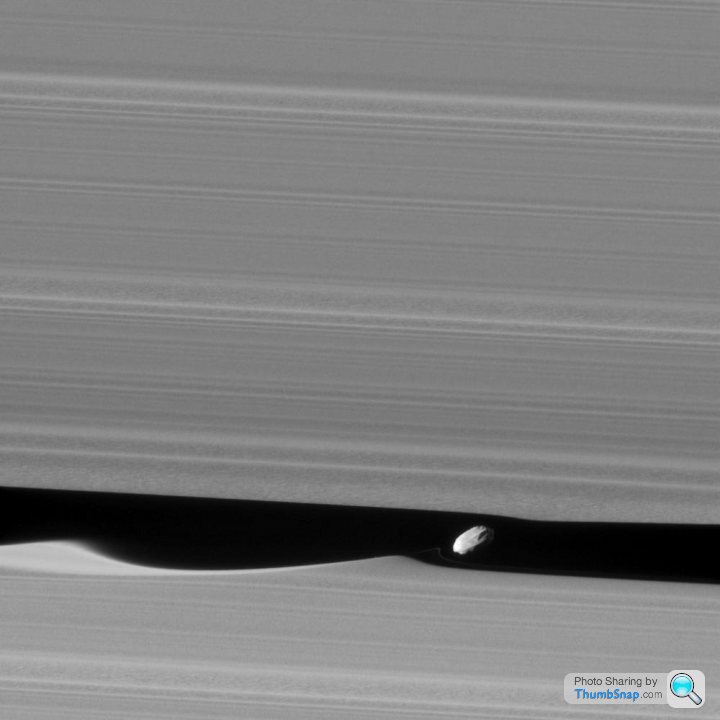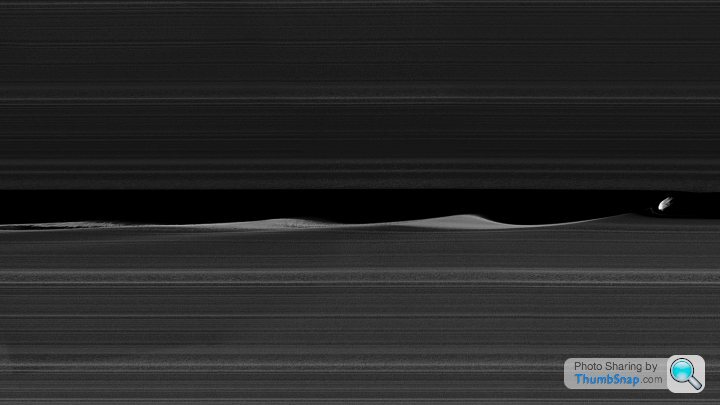Saturn images - Cassini
Discussion
Sensors and electronics in general, when put into space, have to put up with conditions rarely found on earth and so many modern imaging chips and other components just wouldn't survive, which is partly why cameras have relatively low resolutions and processors are much slower than we are used to, even taking into account the delay from design to launch.
And another. Getting up close and personal now.
Daphnis
A shepherd moon. Looks more like a pistachio nut. Albeit a big one.
Credit from here
http://photojournal.jpl.nasa.gov/catalog/PIA21056

Daphnis
A shepherd moon. Looks more like a pistachio nut. Albeit a big one.
Credit from here
http://photojournal.jpl.nasa.gov/catalog/PIA21056

Fascinating picture! What exactly is the process causing the turbulence/wake? Assuming the moon is moving left->right. I can see why nearby ring would be pulled towards the moon (the part just behind the moon), but looking further back it seems to recoil back towards the ring somehow creating a wavy effect ?
Edited by scorp on Tuesday 24th January 10:13
scorp said:
Fascinating picture! What exactly is the process causing the turbulence/wake? Assuming the moon is moving left->right. I can see why nearby ring would be pulled towards the moon (the part just behind the moon), but looking further back it seems to recoil back towards the ring somehow creating a wavy effect ?
Sorry, missed the ask. It is the small body that is probably a captured object and its orbit is inside the rings. The wavy effect, without checking, probably the moon gravity as it passes the ring material and the material is pulled back as it passes.Edited by scorp on Tuesday 24th January 10:13
A quick google and there is this.
http://www.planetary.org/blogs/emily-lakdawalla/20...
Certainly a lot more going on.
Cassini updates a few. Stunning, but the scale is big.
https://saturn.jpl.nasa.gov/news/2993/close-views-...
https://saturn.jpl.nasa.gov/resources/7593/
Reading the caption for this image, more moons than they know what to do with.
Edit.
Caption says
"Ring Propellers
The view shows a section of the A ring known to researchers for hosting belts of propellers -- bright, narrow, propeller-shaped disturbances in the ring produced by the gravity of unseen embedded moonlets."

https://saturn.jpl.nasa.gov/news/2993/close-views-...
https://saturn.jpl.nasa.gov/resources/7593/
Reading the caption for this image, more moons than they know what to do with.
Edit.
Caption says
"Ring Propellers
The view shows a section of the A ring known to researchers for hosting belts of propellers -- bright, narrow, propeller-shaped disturbances in the ring produced by the gravity of unseen embedded moonlets."

Edited by jmorgan on Tuesday 31st January 09:46
jmorgan said:
And another. Getting up close and personal now.
Daphnis
A shepherd moon. Looks more like a pistachio nut. Albeit a big one.
Credit from here
http://photojournal.jpl.nasa.gov/catalog/PIA21056

Looks like there is a tiny moonlet on the left hand slope of the middle ring wave.Daphnis
A shepherd moon. Looks more like a pistachio nut. Albeit a big one.
Credit from here
http://photojournal.jpl.nasa.gov/catalog/PIA21056

jmorgan said:
Sorry, missed the ask. It is the small body that is probably a captured object and its orbit is inside the rings. The wavy effect, without checking, probably the moon gravity as it passes the ring material and the material is pulled back as it passes.
Could it be because the moon is spinning so it's gravity is constantly changing?Dunno, thought of that but was not sure if these are locked or turning.
Edit. having a butchers at Wiki
https://en.wikipedia.org/wiki/Daphnis_(moon)
Discovered in 2005, but theorised it was there from its effects on the ring.
Edit. having a butchers at Wiki
https://en.wikipedia.org/wiki/Daphnis_(moon)
Discovered in 2005, but theorised it was there from its effects on the ring.
Edited by jmorgan on Tuesday 31st January 13:10
jmorgan said:
Sorry, missed the ask. It is the small body that is probably a captured object and its orbit is inside the rings. The wavy effect, without checking, probably the moon gravity as it passes the ring material and the material is pulled back as it passes.
A quick google and there is this.
http://www.planetary.org/blogs/emily-lakdawalla/20...
Certainly a lot more going on.
I guess the force oscillating the ring back to it's original state is centrifugal then ? Or is it the moon itself that has a wobbly orbit?A quick google and there is this.
http://www.planetary.org/blogs/emily-lakdawalla/20...
Certainly a lot more going on.
Edited by scorp on Wednesday 1st February 09:21
Daphnis, more detail of the Keeler gap.
https://saturn.jpl.nasa.gov/resources/7604/?catego...
http://photojournal.jpl.nasa.gov/catalog/PIA17212
Edit. For scorp question page 2
https://saturn.jpl.nasa.gov/resources/4543/
https://saturn.jpl.nasa.gov/resources/4606/
Guessing here, the spin of the planet and gravity pull it all back into shape. Earths view of Saturn also moves with respect its position (plane??). I have looked at Saturn one year and get the rings edge on then another and you can see down onto (up to) them.

https://saturn.jpl.nasa.gov/resources/7604/?catego...
http://photojournal.jpl.nasa.gov/catalog/PIA17212
Edit. For scorp question page 2
https://saturn.jpl.nasa.gov/resources/4543/
https://saturn.jpl.nasa.gov/resources/4606/
Guessing here, the spin of the planet and gravity pull it all back into shape. Earths view of Saturn also moves with respect its position (plane??). I have looked at Saturn one year and get the rings edge on then another and you can see down onto (up to) them.

Edited by jmorgan on Wednesday 8th March 07:59
That is a superb image- hard to visualise the speed of the moon as it moves past the ring fragments, looks like its "surfing" and the collisions and impacts in the ring would be very interesting to see, I wonder if Cassini will get close enough to see more? If not I wonder if the evidence of motion and intereaction in the rings will justify a follow up orbiter to look into it?
It is due to end in September.
https://saturn.jpl.nasa.gov/mission/saturn-tour/wh...
Ring grazing dates
https://saturn.jpl.nasa.gov/news/2967/ring-grazing...
https://saturn.jpl.nasa.gov/news/2966/ring-grazing...
Another handy thing is
https://eyes.nasa.gov
Download the app and you can surf the space craft so to speak. And many other missions.
https://saturn.jpl.nasa.gov/mission/saturn-tour/wh...
Ring grazing dates
https://saturn.jpl.nasa.gov/news/2967/ring-grazing...
https://saturn.jpl.nasa.gov/news/2966/ring-grazing...
Another handy thing is
https://eyes.nasa.gov
Download the app and you can surf the space craft so to speak. And many other missions.
Gassing Station | Science! | Top of Page | What's New | My Stuff




 That's amazing!
That's amazing!